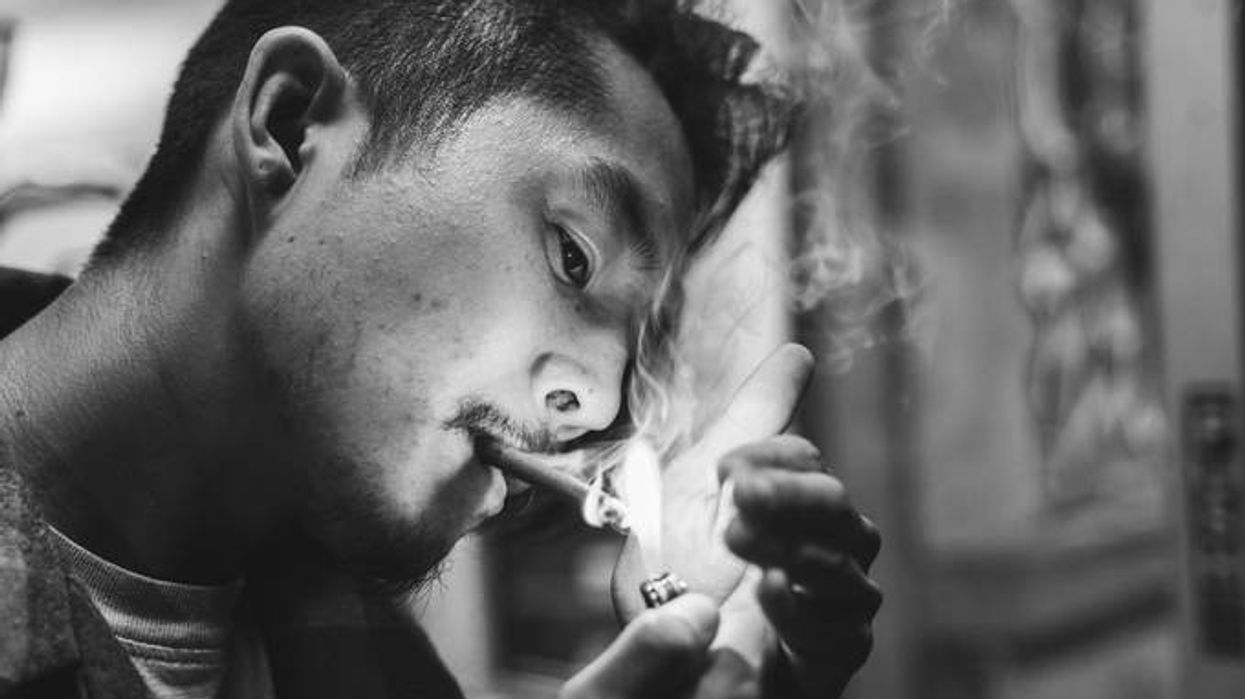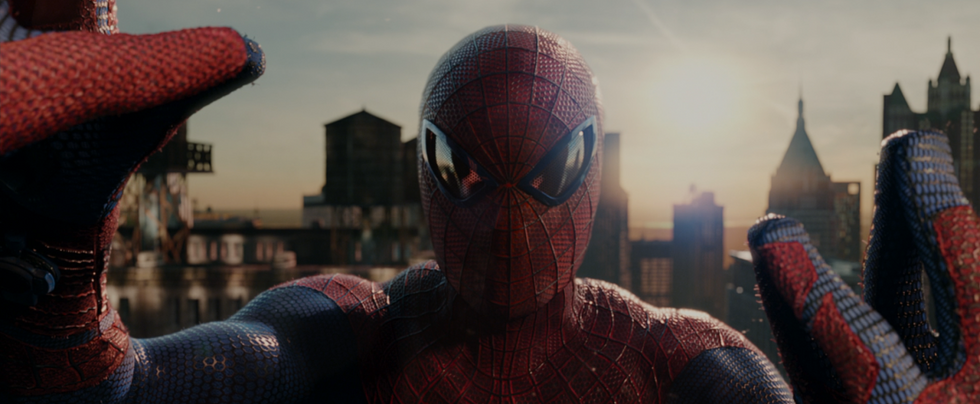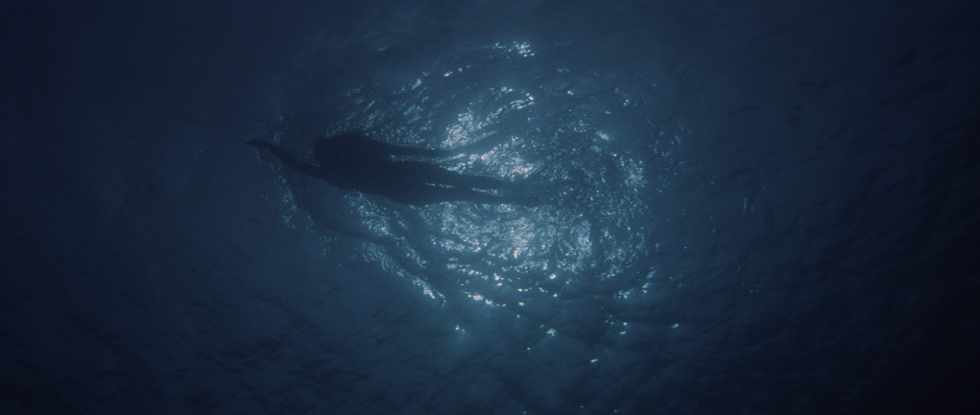From 'Twilight' Star to Sundance-Winning Director: Justin Chon on Black and White 'GOOK'
"The way I learned was just being on set."

The unusual alchemy of Sundance Audience award-winning GOOK allows it to accomplish many things at once: it's poignant, raw, artful, violent, and hilarious. Oh, and there are dance numbers. The film’s emotional impact comes out of left field— particularly as its director, Justin Chon, was heretofore best known as an actor in the teen vampire phenomenon Twilight.
GOOK explores the intense racial tensions in ‘90s Los Angeles from a perspective not often illuminated: Korean-American immigrants. In it, Chon, who also wrote and directed), plays Eli, who is trying to hold on to his deceased father’s failing discount shoe store, where he employs his affable but hapless wannabe soul singer brother, Daniel (David So). Enter 11-year-old Kamilla (Simone Baker), an intensely charming misfit and unlikely friend to the brothers. The layers of their relationship and those of their respective communities play out against the backdrop of the Rodney King beatings and subsequent South Central riots.
No Film School met up with Chon and his talented up-and-coming DP Ante Cheng after GOOK's Sundance world premiere to learn about their choice to shoot in black and white, the decisions necessary to successfully execute a low-budget feature, and more.
"We felt black and white would allow us to really see into the heart of the story, instead of being distracted."
NFS: Justin, after your screening, you called yourself “an actor's director.” What does that mean?
Justin Chon: It means that I want to do everything I can to allow for the best work to come out of my actors—whatever I need to do to facilitate the environment for them to do their best work. For me, rehearsals are very important because we can talk about any concerns. I'm a big conversationalist. We can work things out. I don't like surprises.
I also don't like big conflict on set, so if there are any things that they don't agree with, I want [actors] to tell me beforehand so we can work it out and not waste time. With indie film, you’re so limited with time, that you shouldn't be talking about things that deal with the character on set.
Ante Cheng: Justin is an actor's director and you could feel it just by the environment he creates on set. Working with two almost first-time actors, we would have no marks. They could roam free, do whatever they feel like. And the camera followed where the story was going.

NFS: Your phenomenal lead, Simone Baker, is very young. And David So is a comedian, not an actor. How did you coax such moving performances out of lesser-trained actors and non-actors?
Chon: Part of it was the rehearsals, but also when I picked them in the first place, I could see their inherent talent right off the bat. I knew that they could pull off the roles. The biggest thing is getting them to be comfortable with just being on set, with the camera.
With David, at first, he was [playing the role] a little bit big, and I kept being like, "Just don't try to do anything. Just say the lines. I wrote this for you. Just talk."
I think with people who don't have as many credits, there's an advantage where they don't have this tool bag where they can rely on these "phoning in"-type of performances.
Cheng: I had to shoot almost by instinct and feed off the vibes. Every take they would do different stuff. When Justin knows he's off camera, he would sometimes direct by acting. You know, he's changing all his lines or his acting style to bring up a better performance by them. He had the toughest job because he would prioritize a lot of the actors. Once everyone get good takes, you come up to him and the camera would be on him at last, when he's exhausted. It was definitely a unique experience.
Chon: It's a group effort. If they don't shine, we don't have a movie.
Cheng: Also, he wants to keep it fresh, so there's a lot of rehearsals, but there was no camera rehearsal. That puts so much pressure on our department. We know the script well, but we'd have no clue what he's going to do and we have to nail it on the first take, because we know that it's probably going to be the take that's going to be used. When we watched the dailies, we'll usually find out the first take was the best.
"I didn't go to film school. The way I learned is just being on set and constantly asking questions."
Chon: Always the first take. I know it's a lot of pressure, but that's why I did really want Ante on this film. We were doing an experimental short together, and he was so great with handheld and being intuitive with the camera--when to come in, when to come out. It's very hard to find someone who has that intuition with the dynamic of the actors and all that.
Cheng: A good thing about shooting very few takes is that we all got to hang out. The days would end early, and we'd all hang out and eat. They'd take me to eat a lot of Korean food. It actually bonded us as a family early on.

NFS: How did you find and cast Simone Baker?
Chon: I auditioned a lot of Disney and Nickelodeon girls, and they were too polished. You could tell they rehearsed it with their parents when they came in. That was fine, but it wasn't what I was looking for.
We started calling all the African-American churches in the greater Los Angeles area, and we found the Fernando Pullum [Community Arts] Center. The first day I went in, I saw all the kids and I told them, "Hey, this is what we're doing. We're looking for somebody. Is anyone interested in that?" All the kids raised their hands, and I saw her and I'm like, "Okay, she's the one."
NFS: You didn't even hear her speak or anything?
Chon: No, because I could see her energy. You could tell she was shy, but there was something about her that I just instantly started being magnetized towards her. Then Fernando Pullum brought her over and said, "Hey, sing for the boys." I was like, "Yeah, okay, I'd love to hear you sing." She started singing. This shy girl... when she sang, it was like, "Whoa."
Out of courtesy, I auditioned everybody and they read the script, but when she came in, we did some improv. She would put some adults to shame. She was so invested. She already understood the circumstance, where her character was coming from. It wasn't a very hard choice.
NFS: Talk about the decision to use black and white.
Chon: It was always the original intention. When I approached Ante, I said, "I want to shoot this in black and white. What camera are we going to use? What lenses are we going to use?" Right off the bat, he showed me his black and white stills that he took on film. I became really confident that he was going to do right by that. As for the technical aspect, Ante would give me options. A lot of it's dictated by budget.
Cheng: We knew black and white was a stylized choice. Everything just felt more pure. We were going to be shooting around LA, where it was going to be messy. For this, we felt black and white would allow us to really see into the heart of the story, instead of being distracted.
We watched a lot of the black and white movies over the decades. Even a lot of stuff from the ‘90s, the music videos and the news footage from the actual riot itself.
"We're referencing the Schindler's List DP, Janusz Kaminski."
Chon: Ante grabbed a lot of screenshots of famous films. One of the stills that he pulled up was Schindler's List. I was like, "What the hell? What is this?" But [the reference] is in there. It's in there with the lights coming through the windows and stuff like that.
Cheng: We're referencing the Schindler's List DP, Janusz Kaminski. Even though this has a really realistic, natural look to it, we can still take liberties to stylize and give an expressionistic feel to it.
Chon: Also, in terms of the color, we never saw it in color on the monitors. We always were watching it black and white.

Cheng: We shot on the RED EPIC Dragon, with Kowa Anamorphic primes. We did a bunch of tests on the lenses. We settled on the Anamorphics just because the texture of the rendering, especially in black and white, brings out so much more that's not there anymore with the longer lenses. We kept it pretty simple, like Justin said. We had a pretty humble budget.
NFS: What about your lighting choices? It looked very rich.
Chon: Yeah, there are a lot of conscious lighting choices.
Cheng: We shot in RED Raw in 6K, which was way more than what we needed. We needed the full crop because RED crops the sensor, but the editors were going crazy. I think we filled up their hard drive by day two.
Chon:Also Ante was so adamant about trying to shoot at the right time of day for the sun placement. We had an AD, but I'm also AD'ing myself a lot of times.
Cheng: We'd sit down and stare at the schedules, like, "How is this possible?” Because the film is set over 24 hours and we shot in about 20 days.
Chon: When you're talking about richness, a lot of that is just because of the natural placement of the sun, where the light is shining into the store.
Cheng: The production designers did a good job. Justin found a plot of land, and the store which they built and dressed was facing east. It was also a nice thing that about half of the film takes place in one location. We knew that the sunlight would come in in the morning and eventually would go away. We knew the path and when to go outside. When it's setting, we'd shoot west.
"The editors were going crazy. I think we filled up their hard drive by day two."
Chon: Also, with working with Simone, she could only stay on set five hours on the weekdays [because of her age]. On the weekends, only seven hours. The biggest problem was night shoots. In the summer, the sun goes down at 8:30. She can only be out until 11:00 or 11:30. That only gave us three hours to shoot a day. She's in most of the scenes, so I had to reach out to a labor board and get an exemption to extend it to 12:30.

NFS: Another nontraditional choice besides the black and white was the choreography, which I found beautiful and fascinating. What was the decision-making around that?
Chon: It was always in the original script. I feel like film is escapism and there's a lot of liberties it can take. As long as it follows the emotional path of the actor, I think anything goes.
For the dancing and the choreography, I felt like that was an opportunity to show why Kamilla keeps coming back to the store. She finds inclusion there. She finds family there. To accentuate that, I wanted to show how she feels being there. It's this magical moment. Eli might be kind of brash at times, but there's these moments where they have beautiful connection and can let loose. I didn't want that to be so realistic. That's a moment where I thought we can go outside the box a little bit and make it a little bit more fantastical.
“Working with two almost first-time actors, we would have no marks... the camera followed where the story was going.”
Those kind of choices, I think, if they’re well thought out and placed where it makes sense, they're okay. One of those was when Eli and Kamilla just had a beautiful moment in the car and this conversation where he just gave her shoes. They're on this emotional high. Let's take it one step further because we know where we're going after that scene. That was a choice early on.
In terms of shooting it, we were racing against the clock. Ante is trying to figure out the lighting and stuff. We are running out of time with Simone. It was actually kind of messy.
Cheng: Simone definitely has her own dancing style. When she's dancing solo, that was not choreographed. That was her own style. Justin was like, "Do your own thing." I was amazed by it.
Chon: We brought in a choreographer. They taught us some stuff. We shot a ton. The disco ball was my idea, but lights turning on at different moments and pushing in on Simone, that was Ante. It's a collaboration.

NFS: In the Q&A after your screening, it was mentioned that people worked on your film for reduced rates. How did you convince folks to get on board and what do you think you were able to provide for them, if it wasn't money?
Chon: First of all, in any production, when it comes to studio or the most bottom level non-union, you have to respect people and you have to let them know that they're valued and that they're doing you a favor. It needs to be established very early on how much what they're doing is helping you. Gratitude goes a long way.
I never disrespect people on set, except for my producer. I get really angry at him. To the crew, no. They're helping me and I make sure I say thank you every day. That goes a long way. Also, getting them on board with the idea. When you first meet, you tell them what your intention is and what your vision is. Getting them really in love with where you're trying to go also goes a very long way, because then they feel like it's something very worthwhile.
“As long as it follows the emotional path of the actor, I think anything goes.”
If you do some really sort of kitschy horror movie or whatever where you're just trying to make money, [the crew] will feel that. If your purpose is to make money, they will know. That's the kiss of death because everybody is just there just to make a few hundred bucks a day.
NFS: Ante, what got you on board and kept you motivated it without a bigger budget?
Cheng: I'm just grateful for the opportunity to work with Justin and James [J. Yi, producer]. It's my first feature in the US. I haven't even gotten out of school yet.
Chon: He's still at USC grad.
NFS: No way! You're so talented!
Cheng: I’m just really humbled. It was a very liberating experience because Justin gave me so much creative freedom to believe in my own style.

Cheng: I would drive with James to set every morning and he would give me pep talks every day in the car. It was a really nice experience telling one story over the course of 20-something days to really know what we're trying to do in each scene, each shot. Plenty of the people on the crew have a ton more experience, but I think everyone [was] just happy to spend the summer telling one story.
“I have to be humble enough to know that I don't know the best answer all the time.”
Chon: One final thing is, as a director, you cannot make a film by yourself. If these people are coming to help me, I really have to respect them as artists.
Ante and I butted heads a lot, but I would never shut him down and I would always listen and hear his logic for why he wanted to do something a certain way. If it made sense, I was like, "Absolutely." If it didn't make sense, we'd have a conversation. There [are] certain battles where you're like, "You know what? Let's do it your way," even though it may not have been exactly what I thought.
Working with a lot of people at once, you have to be fluid like that. It’s the same for the art department and the wardrobe. I have a lot of respect for what they do and their specialty and I have to be humble enough to know that I don't know the best answer all the time. For a lot of directors, ego gets in their way.
NFS: Justin, what’s your advice for someone who might be juggling triple or quadruple roles on their film like you did on Gook?
Chon: My biggest tip is to just go do it. Do it, even if you have to just use your phone. Go get your friends together and direct something. Fill every role yourself and see what that's like. The fastest way I learned was making shorts with friends. I'm a huge believer of being in the field and learning by doing, rather than learning from a textbook. I didn't go to film school. The way I learned is just being on set and constantly asking questions of anyone who's knowledgeable about anything. By being curious.
Also, get feedback. Ask friends and tell them to be honest, because if it sucks, you need to know that. That's my advice.
For more, see our complete coverage of the 2017 Sundance Film Festival.


 'The Amazing Spider-Man' (2012)
'The Amazing Spider-Man' (2012) 'Jaws' (1975)
'Jaws' (1975)









